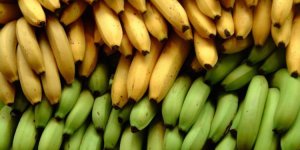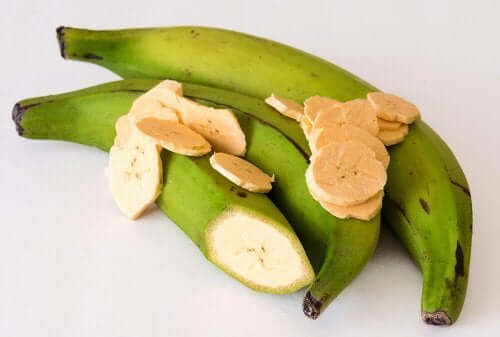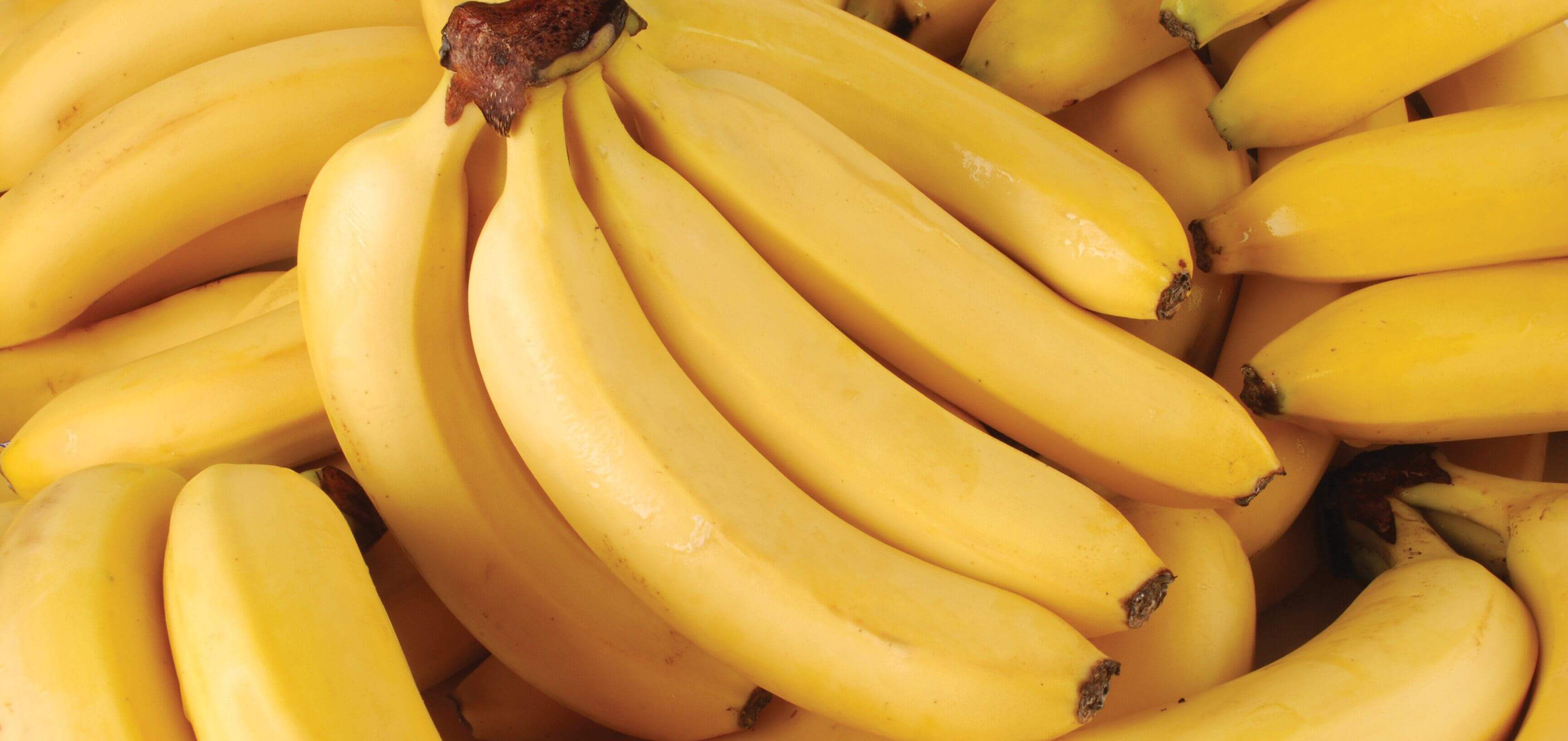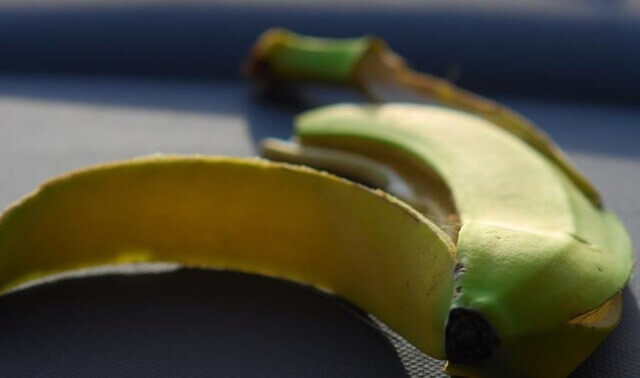Three Nutritional Differences Between Bananas and Plantains

Bananas and plantains are fruits that originate from countries with tropical and hot climates.
They are usually considered a basic food in the population’s daily diet and they provide a large quantity of benefits for those who consume them.
These fruits have a similar appearance and come from the same plant family: Musaceae (source: Venezuelan National Institute of Agricultural Research) Also, they are used in different ways when it comes to cooking- whether they are fried, boiled, baked, grilled or raw.
This is not only because of their small differences in texture and taste, but also because of their nutritional values.
If you want to learn the difference between bananas and plantains, we suggest that you keep reading this article. Don’t miss out!
Plantains
As we have already stated, plantains are a fruit that comes from the Musaceae family, the paradisiacal type.
Because of this, they can easily be found in tropical countries that are close to the coast where it is very hot, such as Mexico, Ecuador, Brazil, and Costa Rica.
The main characteristic of this fruit is its long shape and green peel that turns yellow as it ripens and black when it’s past its ripeness.

The nutritional value of 100 grams of plantain are:
- Energy value: 96.4 kcal
- Fiber: 2.5%
- Calcium: 7.8 mg
- Magnesium: 38.5 mg
- Iron: 0.3 mg
- Copper: 0.1 mg
- Zinc: 0.2 mg
- Manganese: 0.1 mg
- Vitamin: C 17.5 mg
- Protein: 1.7%
- Potassium: 490 mg
- Phosphorus: 59.1 mg
- Carbohydrates: 22.5 %
All of these properties make plantains a juicy fruit when they’re ripe. However, they also contain starch: this contains carbon, oxygen, and hydrogen.
The starch makes it so that you cannot eat plantains before cooking them because they are astringent, rubbery and dry.
- Generally, when they are green, they can be cooked in hot oil, parboiled or boiled.
- If it is ripe or yellow, you can also cook it in the oven and on the grill.
Bananas

Their main characteristics are their cylindrical, soft and smooth shape. They’re white on the inside with a green peel that turns yellow as it ripens.
The nutritional value of 100 grams of a banana are:
- Energy value: 110.15 kcal
- Fiber: 2.3%
- Calcium: 12.5 mg
- Magnesium: 41.5 mg
- Iron: 0.9 mg
- Copper: 0.3 mg
- Zinc: 0.2 mg
- Manganese: 0.1 mg
- Vitamin C: 18.5 mg
- Protein: 0.3 mg
- Potassium: 434 mg
- Phosphorus: 59.1 mg
- Carbohydrates: 26.2%
Unlike plantains, bananas do not contain starch so they can be eaten without having to cook them before.
Also, they are known throughout the world for their sweet flavor and creamy consistency. That makes them one of the best foods to eat at any time of the day.
Differences between bananas and plantains

Despite having almost the same characteristics, we’ve seen some differences that distinguish them. This study from the University of Colima (Mexico) also establishes several options for determining their particular characteristics.
We’re also going to take a look at other properties of bananas and plantains that highlight the differences between these two fruits.
1. Microminerals
Plantains contain a lower quantity of microminerals than bananas, such as:
- Iron
- Copper
- Zinc
- Manganese
- Sodium
However, they contain more potassium. A study from the Necker Hospital in Paris found that potassium can help prevent muscle cramps and hypokalemia.
They also contain more sodium, beating bananas by 2 grams for every 100 grams.
2. Calories
Plantains have fewer calories, which makes them a better option for maintaining a healthy weight.
3. Protein
Bananas have fewer proteins, but more vitamin A and iron. This makes it an overall healthier option for your body. Plantains, on the other hand, have more protein and are great for weight loss.
Did you know the differences between bananas and plantains? We recommend incorporating both into your diet because they are delicious and nutritious.
All cited sources were thoroughly reviewed by our team to ensure their quality, reliability, currency, and validity. The bibliography of this article was considered reliable and of academic or scientific accuracy.
- Gobierno de Canarias. (2011). Boletín Oficial de Canarias núm. 25. Consejería de Agricultura,
Ganadería, Pesca y Medio Ambiente. Recuperado de: http://www.gobiernodecanarias.org/boc/2011/025/005.html - Fernández, E., López, B., Santurino, C., & Gómez, Candela, C. (2021). Composición nutricional y declaraciones nutricionales del plátano de Canarias. Nutrición Hospitalaria. 38 (6): 1248-1256. Recuperado de: https://scielo.isciii.es/scielo.php?script=sci_arttext&pid=S0212-16112021000700020
- Ferrer, A., Marques, I.,& Vercet, A. (2016). Informe sobre las características diferenciales entre el plátano de Canarias y la banana de distintas procedencias. Facultad de Ciencias de la Salud y el Deporte. Universidad de Zaragoza. Recuperado de: https://silo.tips/download/caracteristicas-diferenciales-entre-el-platano-de-canarias-y-la-banana-1
- Fundación Española de la Nutrición (FEN). Frutas: Plátano. Página 295. Recuperado el 11 de abril del 2023 en: https://www.fen.org.es/storage/app/media/flipbook/mercado-alimentos-fen/008/index.html#p=53
- Harvard School of Public Health. The nutrition source: Bananas. Recuperado el 11 de abril del 2023 en: https://www.hsph.harvard.edu/nutritionsource/food-features/bananas/
- Ministerio de Agricultura, Pesca y Alimentación. I.G.P. Plátano de Canarias. Recuperado de: https://www.mapa.gob.es/es/alimentacion/temas/calidad-diferenciada/dop-igp/frutas/IGP_Platano_Canarias.aspx
This text is provided for informational purposes only and does not replace consultation with a professional. If in doubt, consult your specialist.








